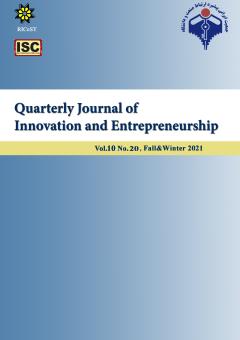Identifying the factors affecting the formation of free innovation process in Iran Using fuzzy Delphi approach and Dematel technique
Subject Areas : عمومىali asghar sadabadi 1 , mohammad sadegh khayyatian 2 , fatemeh mohammadi 3
1 - Assistant Professor, Institute for Basic Studies of Science and Technology, Shahid Beheshti University, Tehran, Iran
2 - Assistant Professor, Institute for Basic Studies of Science and Technology, Shahid Beheshti University, Tehran, Iran
3 - MSc Student in Science and Technology Policy Research Institute of Basic Studies in Science and Technology, Shahid Beheshti University, Tehran, Iran
Keywords: Free Innovation, Individual Factors, Underlying Factors, Environmental Factors, Fuzzy Delphi, Dematel Technique,
Abstract :
Free innovation is an important and evolving process in the domestic sector of national economies, leading to human prosperity and social welfare. The main purpose of this study is to identify the factors affecting the process of forming free innovation in Iran with fuzzy Delphi analysis and Dematel technique. The statistical population of the study is all experts in the field of free innovation that 12 experts from Shahid Beheshti, Allameh Tabatabai, Tehran, Imam Sadegh (AS) universities were selected and finally 12 Delphi questionnaires were completed and analyzed by the researcher. it placed. According to the results of fuzzy Delphi technique in the panel of experts, 8 components affecting the formation of free innovation process were identified and classified into three main groups. Then, in order to investigate the effect and effectiveness of the subcomponents, these factors were measured by the dimethyl technique. The results show that among the three factors affecting the formation of the free innovation process, the environmental factor has the most impact and individual and contextual factors are in the next ranks. Also, among the 8 sub-components, the factor of culture of understanding and supporting innovation has the most impact among other factors
• Ackermann F. (2012) "Problem structuring methods ‘in the Dock’: Arguing the case for soft OR", European Journal of Operational Research, Vol. 219, No. 3,pp. 652-658.
• Ackermann F., Eden C. (2010) Systems approaches to managing Change: Apractical guide. Published in association with Spring Verlag London limited, pp.135-190.
• Baldwin, C. Y. 2008. Where do transactions come from? Modularity, transactions and the boundaries of firms. Industrial and Corporate Change 17(1): 155-195.
• Baltar, Fabiola & Ignacio Brunet (2012). "Social Research 2.0: Virtual Snowball Sampling Method Using Face book", Internet Research, 22(1): 57–74.
• Bouzon, M., Govindan, K., Rodriguez, C.M.T., & Campos, L.M.S. (2016); “Identification and Analysis of Reverse Logistics Barriers Using Fuzzy Delphi Method and AHP”, Resources, Conservation and Recycling, Vol. 108, pp. 182-197.
• Cheng, Ch. & Lin, Y. (2002). Evaluating the best mail battle tank using fuzzy decision theory with linguistic criteria evaluation. European Journal of Operational Research, (142):147-186
• de Jong, J.P.J.2013. User innovation by Canadian consumers: Analysis of a sample of 2,021 respondents. Unpuplishedpaper commissioned by Industry Canada.#3 • Eden C., Ackermann F. (2001) "Strategic options development and analysis: The principles", In: Rational Analysis for a Problematic World Revisited: ProblemStructuring Methods for Complexity, Uncertainty and Conflict, 2nd Edition, United Kingdom: Wiley, pp. 21-42.
• Fisher, W. W., III. 2010. The implications for law of user innovation. Minnesota Law Riview 94(May): 1417-1477.
• Kim,Y.2015.Consumer User innovation in Korea: An international comparison and Policy implication. Asian Journal of Technology Innovation 23(1): 69-86.
• Martínez-Noya, A., & García-Canal, E.( 2011). Technological capabilities and the decision to outsource/outsource offshore R&D services. International Business Review, 20(3), 264-277.
• OECD. 2009. Society at a Glance 2009: OECD Social Indicators. Accessed Janu-ary 30,2016.http://www.oecdbookshop.org/geti.php?REF=5KZ99FKTLPTB& YPE=browes.
• Osli Manual. 2005. Oslo Manual: Guidelines for Collecting and Interpreting Innovation Data, third edition. 2005. Statistical Office of the European Communities, Organisation for Economic Co- Operation and Development.
• Samuelson, P. 2015. Freedom to tinker. UC Berkeley. Public Law Research paper 3605195, University of California, Berkeley. Theoretical inquiries in Law, forthcoming. Available at SSRN: http://paoers.ssrn.com/sol3/papers.cfm ?abstract id=2605195
• Tedelis, S., and O.E. Williamson. 2013. Transaction cost economics. In Handbook of Organizational Economics, ed. Robert Gibbons and John Roberts. Princeton University Press.
• Von Hippel, E. A,J.P.J. de Jong, and S. Fiowers.2012.Comparing business and household sector innovation in consumer products: Findings from a representative survey in the United Kingdom. Management Science 58(9):1669-1681 .
• Von Hippel, E., S. Ogawa, and J. P. J. de Jong. 2011. the age of the consumer- innovator. Sloan management Review 53(1): 27-35.
• Gabus, A., Fontela, E. (1972). World Problems an Invitation to Further Thought within the Framework of DEMATEL. Switzerland Geneva: Battelle Geneva Research Centre.
• Trevithick, S. Flabouris, A., Tall, G., Webber, C., (2003). International EMS systems: New South Wales. Australia, Resuscitation, 59 (2):521-70.


